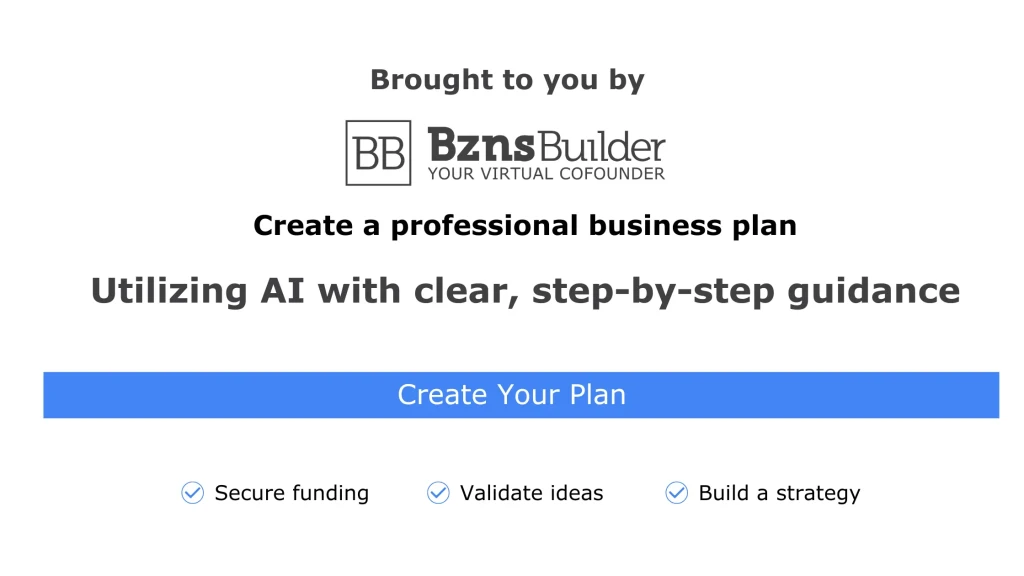How to Write a Business Plan: A Guide for Small Businesses

Creating a business plan doesn’t have to be overwhelming—especially when you know how to write a business plan effectively. With the right tools, you can craft a professional, detailed, and investor-ready plan that truly stands out. Whether you’re launching a new venture, managing daily operations, or scaling your business, BznsBuilder’s AI-powered platform turns your vision into a strategy for success, making the process simple and rewarding.
The Basics of Writing a Business Plan
If you’re here, you likely already understand the importance of having a business plan.
A well-crafted business plan helps you:
- Raise Capital: Attract investors and secure funding with confidence.
- Strategize Growth: Outline clear, actionable steps to scale your business.
- Stay Focused: Keep your business aligned with its goals and priorities.
Before diving into the details, take a moment to zoom out and reflect on what a business plan truly is—a roadmap that outlines your vision and guides your business toward success. With tools like BznsBuilder, crafting a professional plan becomes a seamless, empowering experience.
What is a Business Plan?
At its core, a business plan is a blueprint for your business. It outlines:
- What You Sell: An overview of your products and services.
- Who You Sell To: A clear picture of your target customers.
- How You’ll Succeed: Your strategy for building and growing your business, including your marketing approach and competitor analysis.
Types of Business Plans
A robust business plan also includes financial forecasts—projections for sales, expenses, profits, and cash flow. These forecasts not only help you set realistic goals but also prepare you to navigate the financial aspects of your business.
But a business plan is much more than a one-time document. It’s a dynamic guide that helps you stay focused and track your progress toward your goals. As you move forward, regularly updating your forecasts and budgets ensures your business remains agile, informed, and on the right track.
There are various types of business plans to suit different needs, but we’ll focus on the most common format—one that’s investor-ready and comprehensive.
If you’re just starting out or need a simpler approach, consider creating a one-page business plan. It’s quick to develop, easy to use, and perfect for refining your ideas or establishing a straightforward strategic framework.
Later in this article, we’ll dive deeper into how to use your business plan as a management tool and how to adapt it over time. Whether you’re building a detailed investor pitch or starting with a simple roadmap, tools like BznsBuilder can streamline the process and set you up for success.
What to Include in Your Business Plan
Executive Summary
The executive summary is a concise overview of your business and its goals, providing a snapshot of the complete plan. Positioned at the beginning of your business plan, it should be kept brief—typically one to two pages. However, many entrepreneurs find it easiest to write this section last, as it summarizes the entire document.
A well-crafted executive summary can often serve as a stand-alone document that captures the key highlights of your business plan. This is particularly useful when pitching to investors, who frequently request only the executive summary for an initial evaluation. If your summary resonates, they may request the full plan, a pitch presentation, or detailed financial projections.
Your executive summary should include:
- A clear explanation of the problem you are solving.
- A succinct description of your product or service.
- An outline of your target market and its potential.
- A brief introduction to your team and their qualifications.
- Key points from your financial projections.
- A summary of your funding needs, if applicable.
Using this approach ensures that your executive summary highlights the essential aspects of your business, attracting interest and prompting deeper engagement from stakeholders.
Products and Services Description
The products and services section of your business plan is your opportunity to clearly articulate what you are offering and how it addresses a specific problem for your target market. Start by defining the problem your customers face, followed by a detailed explanation of how your product or service provides an effective solution. This structure, often referred to as the problem and solution statement, ensures your offerings are positioned as essential and impactful.
To showcase the true value of your product or service, craft a compelling narrative. Explain how your offering will transform your customers’ lives or streamline their work. A strong, engaging story not only communicates the value but also keeps readers invested in your business plan.
This section should also highlight any competitive advantages your business holds. These may include intellectual property, patents, proprietary technology, or unique processes that differentiate your offering from competitors. If you have evidence of traction, such as initial sales, contracts, or customer interest, include it here to demonstrate the potential success of your business.
By effectively conveying the value, uniqueness, and viability of your products or services, you establish credibility and instill confidence in your readers, whether they are potential investors, lenders, or partners.
Market Analysis
The market analysis section of your business plan provides a detailed overview of your target market, giving insight into who your customers are and why they need your product or service. This part of your plan demonstrates your understanding of the market and lays the groundwork for how your business can effectively reach and serve its audience.
Your target market is a description of the specific group(s) of people you plan to sell to. Depending on the nature of your business, you may have multiple target markets. For instance, a business might target both retail customers and wholesalers.
To create a comprehensive market analysis, include:
- Demographics: Be as precise as possible by describing your customers’ age, income level, location, gender, and other measurable characteristics.
- Psychographics: Dive deeper into their interests, preferences, behaviors, and habits, particularly as they relate to your product or service.
Additionally, discuss the growth trends in your industry and target market. Highlight statistics or reports that indicate an increasing demand for your offering or opportunities for expansion. This reinforces the viability of your business and its potential for success.
By thoroughly analyzing your market, you can not only demonstrate demand but also refine your marketing and sales strategies to better address customer needs.
When crafting your market analysis, it’s essential to include all relevant insights about your customers that support how your product or service meets their needs. A well-defined target market not only strengthens your business plan but also simplifies the development of a focused sales and marketing strategy. By understanding who your customers are, what they enjoy, and the most effective ways to reach them, you can tailor your approach to maximize impact.
Additionally, provide detailed information about the size and trends within your market. Answer key questions such as:
- What is the size of your market in terms of potential customers or revenue?
- Is the market growing or shrinking?
Highlight data that shows your market is expanding, as this signals opportunities for long-term growth. Include relevant statistics, reports, or forecasts that demonstrate how your business is positioned to capitalize on these changes. For example, if your industry is experiencing innovation or demand shifts, explain how your business is prepared to adapt and thrive in this evolving environment.
By integrating these insights, your market analysis will not only showcase the potential of your business but also instill confidence in stakeholders that you have a clear plan to succeed.
Competitive Analysis
Understanding your competitive landscape is a crucial step in defining your business opportunity and identifying your competitive advantage. This involves not only understanding your competitors but also considering the alternatives that your target customers might choose instead of your product or service.
Every business has competition, even if it’s not immediately obvious. If you think you don’t have direct competitors, examine what alternatives exist in the market. For instance:
- In the early days of automobiles, their main competition was horses.
- For early social media platforms, alternatives included reading books, watching TV, or talking on the phone.
A thorough competitive analysis should:
- Identify competitors: List both direct and indirect competitors.
- Assess their strengths and weaknesses: Highlight areas where they excel and where they fall short.
- Highlight your differentiation: Clearly explain how your business stands out.
Your competitive advantage might be:
- Better quality or more innovative products.
- Lower costs or superior pricing strategies.
- Exceptional customer service.
- Strategic location that makes your offerings more accessible.
- Proprietary technology or intellectual property.
By fully mapping out the competitive landscape and showcasing how your business is distinct, you build a strong case for your market position. This not only guides your strategy but also demonstrates to investors and stakeholders why your business is poised for success.
Marketing and Sales Plan
The marketing and sales plan outlines how you will position your product or service in the marketplace, attract your target audience, and convert potential customers into loyal buyers. This section of your business plan bridges the gap between brand awareness and revenue generation.
Marketing Plan
A strong marketing plan begins with a positioning statement. This statement defines how your business fits into the market and highlights the unique advantages of your product or service. Leverage insights from your competitive analysis to shape your positioning.
For example:
- You might position your business as a premium, high-quality option that justifies a higher price point.
- Alternatively, you could emphasize being a locally-owned business that supports the local economy.
Once you’ve established your positioning, combine it with what you know about your target market to create your marketing strategy. This strategy focuses on how to communicate your message effectively. Depending on your audience and their buying behaviors, you might utilize various channels, such as:
- Social media advertising
- Content marketing (e.g., blogs, videos, podcasts)
- Email campaigns
Your marketing plan should detail how customers will discover your business and why they should choose your products or services over others.
Sales Plan
While the marketing plan is about attracting and engaging customers, the sales plan covers the steps to close the deal once they express interest.
- If your business involves a long sales process or requires a dedicated sales team, describe the steps in this process, including lead generation, nurturing, and closing.
- For businesses with a self-service model, explain how customers can easily make purchases online or through another streamlined process.
A well-crafted sales plan complements the marketing plan. Marketing efforts drive customers to your business, while your sales plan ensures those leads convert into revenue.
By integrating your marketing and sales strategies, you create a cohesive roadmap that shows how you’ll connect with your audience, build relationships, and achieve sustainable growth.
Business Operations
The business operations section of your plan outlines the essential requirements for your business to function effectively. It provides a clear picture of how your business runs on a day-to-day basis and highlights the key processes, tools, and strategies necessary for smooth operations.
Key Elements to Include in Your Operations Plan
The content of this section will depend on the structure and nature of your business. Common elements to consider are:
- Inventory: How you manage stock levels and storage.
- Supply chain management: Your relationships with suppliers and how you ensure timely delivery of materials.
- Manufacturing processes: If applicable, describe how your product is created, including the equipment and resources required.
- Equipment and technology: Highlight any tools or software essential for your operations.
- Distribution: Detail how you get your product or service into customers’ hands.
Distribution for Product-Based Businesses
For businesses selling products through major retailers like Amazon, Walmart, or other large chains, this section should include an analysis of the logistics and costs involved in getting your products onto store shelves. Discuss any potential hurdles, such as supply chain disruptions or retailer-specific requirements, and how you plan to overcome them.
Simpler Business Models
If your business has a simpler structure, that’s perfectly fine. For example, service-based businesses, like physical therapy practices or online software providers, can use this section to explain:
- The technology or platforms they rely on.
- The process of delivering their services.
- Partnerships with other professionals or vendors critical to their offerings.
By tailoring this section to the specific needs of your business, you provide readers with a clear understanding of how your operations are structured to support growth and deliver value to your customers.
Key Milestones and Metrics
While not mandatory, outlining your business’s key milestones and metrics is an invaluable addition to your plan. These elements provide a clear roadmap for success and enable you to track progress over time, ensuring you remain aligned with your goals.
Defining Milestones
Milestones are specific goals that mark significant achievements in your business journey. They help clarify tasks, set expectations, and provide accountability. For each milestone, include:
- A description of the task or goal.
- The proposed due date.
- The person or team responsible for its completion.
- Projected costs, if applicable, to achieve the milestone (especially if you have a budget).
This section doesn’t require detailed project planning but should highlight critical milestones that serve as an overall business roadmap. Examples might include:
- Website launch date
- Store or office opening date
- First significant sales milestone
- Break-even date
- Obtaining business licenses or approvals
Tracking Key Metrics
In addition to milestones, identify the key metrics you will use to measure success. Metrics provide actionable insights into your business’s performance and growth. Common examples include:
- Conversion rates: The percentage of prospects who become customers.
- Customer acquisition costs: The cost of gaining each new customer.
- Profit per customer: Revenue minus the costs associated with each customer.
- Repeat purchases: The frequency of returning customers.
You don’t need to track every possible metric right away. Start with the ones most relevant to your business, and expand over time. Conversely, it’s okay to drop metrics that don’t provide useful insights.
By combining clear milestones with actionable metrics, this section provides a structured way to measure progress and demonstrate your business’s potential to stakeholders.
Organization and Management Team
Investors are drawn to great teams, not just great ideas. This section of your business plan showcases your current team and outlines your hiring needs. It also provides a snapshot of your company’s history, location, and structure, giving stakeholders a clear picture of how your business is organized.
Highlight Your Team
Briefly describe the relevant experiences and qualifications of each key team member. Emphasize why your team is uniquely positioned to succeed in executing the business idea. Consider:
- Does your team have industry expertise?
- Have they achieved previous entrepreneurial successes?
If there are key roles you still need to fill, be upfront about these gaps and highlight your plan for hiring. Investors understand that early-stage businesses are still building their teams, but they’ll want to see a roadmap for assembling the right talent.
Business Structure
Provide an overview of your company’s business structure, as this is a key consideration for potential lenders and investors. Common structures include:
- LLC
- C-corp
- S-corp
- Sole proprietorship
- Partnership
Explain how the business is owned, detailing ownership percentages among founders, investors, and partners. For example:
- Is ownership equally divided among partners?
- Are there any key stakeholders with majority control?
Why It Matters
This section is not just about listing names and titles—it’s about making the case that you have the right team and organizational framework to turn your vision into reality. A compelling description of your team’s expertise and a clear explanation of your business structure instills confidence in potential investors and lenders, making it more likely they will support your venture.
Financial Plan
The financial plan is the final section of your business plan, where you provide an overview of your financial forecasts and strategy. While this may seem challenging, creating a solid financial forecast is often simpler than expected and doesn’t require a formal business degree. A clear and well-prepared financial plan demonstrates to investors and lenders that you have a solid understanding of your business’s financial health and its future potential.
Key Components of a Financial Plan
A typical financial plan includes:
- Sales Forecast
- An estimate of expected sales over a specific period.
- Break down your forecast by key revenue streams to give a detailed picture of where income will come from.
- Expense Budget
- A projection of your planned spending, including categories like personnel costs, marketing, operating expenses, and taxes.
- Profit & Loss Statement (P&L)
- Combines your sales forecast and expenses to calculate your planned profits or losses. This is essential for understanding the overall profitability of your business.
- Cash Flow Statement
- Tracks how cash moves in and out of your business.
- This forecast helps predict how much cash you’ll have on hand at any given time and ensures you can cover operational costs.
- Balance Sheet
- Provides a snapshot of your company’s assets, liabilities, and equity, giving an overview of its financial health.
Assumptions and Risks
A strong financial plan also includes a description of your assumptions about the future and identifies potential risks. These could include market fluctuations, unexpected expenses, or changes in customer behavior. Addressing these upfront shows that you’ve thoughtfully considered challenges and have strategies to mitigate them.
Why It Matters
This section is particularly important if you’re seeking a loan or investment. Investors and lenders will scrutinize your financial plan to evaluate your business’s viability, potential for growth, and ability to generate returns.
By presenting a clear and comprehensive financial plan, you demonstrate that you are prepared to navigate the financial challenges of running your business while positioning it for long-term success.
Appendix
The appendix is where you include additional information, charts, or supporting data that reinforces your business plan. This section allows you to provide further detail without overwhelming the main content, ensuring that your plan remains clear and concise while still demonstrating thorough preparation.
Why Include an Appendix?
Adding an appendix can enhance the credibility of your business plan. It shows readers—whether they’re investors, lenders, or other stakeholders—that your ideas are backed by solid research and detailed planning. This is especially important when presenting data or evidence to support financial projections, market analysis, or operational strategies.
What to Include in the Appendix?
The content of the appendix will vary depending on your business and audience but might include:
- Detailed financial data or projections.
- Charts and graphs supporting your market analysis.
- Resumes of key team members.
- Copies of important licenses or legal documents.
- Any relevant contracts, agreements, or letters of intent.
- Supporting case studies or testimonials.
Keep It Supplementary
While the appendix adds value, remember that it is meant to be supplementary. Your core business plan should stand alone, even if the reader decides to skip this section. The appendix serves as an optional resource for readers who want to dive deeper into specific areas.
By including an appendix, you provide transparency and additional validation, helping readers feel more confident about the strength and viability of your business.
Optional: Business Plan Cover Page
Including a business plan cover page is a simple yet effective way to make your business plan look polished and professional. It serves as the first impression for potential investors, lenders, and partners while providing essential contact information for future reference.
What to Include on the Cover Page
Your cover page should be clean and straightforward, including:
- Company Logo: A visual element that reinforces your brand identity.
- Business Name: Clearly state the name of your company.
- Value Proposition (Optional): A brief statement summarizing your business’s unique value or mission.
- Business Plan Title: Identify the document, such as “Business Plan for [Your Business Name].”
- Completion and/or Update Date: Indicate when the plan was completed or last revised.
- Address and Contact Information: Provide details like your business address, phone number, email, and website.
- Confidentiality Statement: A note to protect your intellectual property, such as, “This document is confidential and intended for the recipient only.”
Why Use a Cover Page?
While optional, a well-designed cover page:
- Enhances the professional appearance of your business plan.
- Makes it easier for readers to contact you or reference your business information.
- Sets the tone for the document, creating a positive first impression.
Keep It Simple
There’s no need to spend excessive time on the cover page. The focus should remain on the content of your business plan. A clear and uncluttered cover page with just the essentials is sufficient to make a professional impact.
How to Use AI to Help Write Your Business Plan
Generative AI tools, like ChatGPT, can significantly streamline the business plan writing process. They can assist in areas such as market analysis, competitive research, and content creation, helping you turn raw ideas into polished, professional text. By leveraging AI, you can save time and gain valuable insights while crafting a comprehensive business plan.
How AI Can Support Your Business Plan
- Speed and Efficiency: AI can quickly generate drafts for sections like the executive summary, market analysis, or product descriptions based on the ideas you provide.
- Brainstorming Partner: AI can act as a collaborative tool, offering suggestions and ideas for your business strategy. It can also help you refine concepts like market segmentation or competitive advantages.
- Polishing Content: AI can help improve the readability, tone, and professionalism of your text, ensuring your business plan is clear and impactful.
AI as a Collaborator, Not a Replacement
While AI is a powerful tool, it’s essential to treat it as a collaborator rather than a complete replacement for human creativity and critical thinking. Here’s why:
- AI generates ideas and content based on patterns and data but lacks the ability to understand your unique business vision fully.
- You know your customers and market better than any AI tool, so you’ll need to evaluate and refine the ideas AI produces to ensure they resonate.
Benefits and Limitations of AI in Business Planning
Pros:
- Speeds up content creation.
- Offers fresh perspectives and ideas.
- Assists with formatting and structure.
Cons:
- May produce generic or unrealistic suggestions without proper guidance.
- Lacks the deep understanding of your business’s specific nuances.
Best Practices for Using AI
- Use AI to generate drafts and brainstorm ideas, but always review and refine the content.
- Provide clear prompts and context to guide AI tools effectively.
- Combine AI-generated content with your knowledge and expertise to create a plan tailored to your business needs.
By thoughtfully integrating AI into your business planning process, you can unlock efficiencies while maintaining the personal touch and strategic insight essential for creating a compelling plan.
Writing Tips and Strategies for Your Business Plan
Creating a compelling business plan can feel like a daunting task, but with the right approach, it becomes a manageable and valuable process. Here are practical tips and strategies to help you streamline the writing process and avoid common pitfalls.
1. Know Why You’re Writing a Business Plan
Understanding the purpose of your business plan will shape how you write it:
- Internal Use: If the plan is for internal use, such as managing your business or outlining goals, you might skip sections like organizational structure or team details.
- Raising Funds: For plans intended to secure investments or loans, prioritize sections explaining why you need funding and how you’ll use it.
Think about your objectives and tailor the content to meet the needs of your audience.
2. Keep It Concise
Simplicity is key.
- Focus on essential information and avoid overly detailed, wordy descriptions.
- Use bulleted lists and short sentences to enhance readability.
Remember, busy investors and lenders are more likely to engage with a concise, well-structured plan than a lengthy, overly detailed document.
3. Get Feedback Early and Often
Don’t write your plan in isolation. Share it with trusted colleagues, mentors, or advisors for feedback.
- Identify areas that might be confusing or leave unanswered questions.
- Incorporate feedback early in the process to address issues before presenting your plan to stakeholders.
For a more in-depth review, consider hiring a professional business plan writer.
4. Use Templates and Examples
Starting from scratch can be intimidating. Leverage tools like:
- Free business plan templates to guide your structure and content.
- Example plans to see how others in your industry have structured their documents.
- Industry-specific guides for tailored advice and best practices.
Accessing a library of templates and examples ensures you’re including the right information and can jump-start your process.
These strategies will help you create a business plan that is not only clear and actionable but also tailored to your goals and audience.
Common Pitfalls in Business Plan Writing and How to Avoid Them
Writing a business plan is an important step, but it’s easy to stumble along the way. Avoid these common mistakes to ensure your plan is both effective and actionable.
1. Not Talking to Your Customers
One of the biggest mistakes is assuming your product or service is what customers want. Without validating your ideas with real feedback, you risk building a business around incorrect assumptions.
How to Avoid:
- Talk to your target audience before finalizing your plan.
- Conduct surveys, interviews, or focus groups to understand customer needs.
- Use this feedback to refine your offerings and demonstrate customer demand in your plan.
2. Overly Optimistic Sales and Profit Forecasts
- Ground your sales forecasts and profit estimates in reality by using industry benchmarks and historical data.
- Consider potential challenges or risks that could impact growth and reflect those in your financial plan.
Entrepreneurs are naturally optimistic, but overly ambitious financial projections can hurt your credibility with investors.
How to Avoid:
3. Spending Too Much Time Planning
- Balance planning with action. Spend time testing your idea, building prototypes, or validating your market alongside writing your business plan.
- Set a deadline for completing your plan to keep yourself accountable.
Planning is essential, but getting stuck in the planning phase can delay the actual launch of your business.
How to Avoid:
4. Not Revising the Plan
- Regularly review and update your plan based on performance and market changes.
- Adjust budgets, revenue forecasts, and strategies to reflect real-world results.
Many entrepreneurs treat their business plan as a static document, but a good plan should evolve as your business grows and you gather new insights.
How to Avoid:
5. Not Using the Plan to Manage Your Business
- Use your plan to track progress, measure performance, and make informed decisions.
- Regularly revisit it to ensure your business stays aligned with your goals and strategies.
A business plan is more than just a document to secure funding—it’s a management tool. Leaving it unused after writing defeats its purpose.
How to Avoid:
By addressing these pitfalls early on, you can create a business plan that not only guides your business but also adapts to its growth and challenges.
Presenting Your Business Plan
The process of writing a business plan does more than create a document—it helps you deeply understand your business by forcing you to consider every detail. This knowledge prepares you to confidently present your ideas, whether to investors, lenders, or team members.
The Value of a Business Plan
The real benefit of creating a business plan lies in the insights you gain:
- You identify potential challenges and solutions.
- You answer critical questions about your market, operations, and finances.
- You build a roadmap that guides your business decisions.
This thorough understanding sets the stage for creating a compelling pitch presentation.
What Is a Pitch Presentation?
- Communicate your business concept quickly and effectively.
- Showcase the most compelling aspects of your plan, such as your value proposition, target market, and financial projections.
- Engage your audience and encourage them to learn more.
A pitch presentation is a condensed version of your business plan, focusing on the highlights and key points. It’s designed to:
Tips for a Successful Presentation
- Focus on Key Points: Highlight your business idea, market opportunity, competitive advantage, and financial forecasts.
- Keep It Visual: Use charts, graphics, and visuals to make your presentation more engaging and easier to understand.
- Know Your Audience: Tailor your pitch to your audience’s priorities. Investors may focus on ROI, while team members may care more about strategy and execution.
- Practice and Prepare: Rehearse your presentation to ensure it’s concise, clear, and confident. Be ready to answer questions and address concerns.
By leveraging the insights from your business plan and focusing on the highlights in your pitch presentation, you’ll be able to effectively communicate your vision and inspire confidence in your audience.
Use Your Business Plan to Manage Your Business
A well-crafted business plan isn’t just for securing funding or attracting investors—it’s a powerful management tool to help you run your business effectively. By providing a clear revenue forecast, expense budget, and cash flow projections, your plan sets measurable targets and offers a roadmap for success.
The Value of Regular Reviews
Business rarely goes exactly as planned, which is why it’s crucial to use your plan as a dynamic tool rather than a static document. Regularly reviewing your plan allows you to compare your forecasts with actual results and make informed adjustments.
Start with a monthly review and ask:
- Did you meet your sales goals?
- Are your expenses aligning with your budget?
- Has anything unexpected occurred that impacts your forecasts?
Adjusting Based on Results
After analyzing your results, make the necessary adjustments to stay on track:
- Exceeding Sales Goals:
- Set more ambitious targets.
- Consider scaling operations, increasing spending, or hiring additional employees.
- Rising Expenses:
- Identify areas to cut costs.
- Reevaluate spending priorities and tighten budgets.
By continuously refining your plan based on real-world data, you ensure your business remains agile and adaptable.
The Tool for Long-Term Success
Using your business plan as a living document helps you navigate challenges and seize opportunities. Regularly updating your plan keeps your goals realistic and actionable, empowering you to make smarter decisions and achieve sustained growth.
Table of Contents
- Market Analysis
- Marketing Plan
- Sales Plan
- Key Elements to Include in Your Operations Plan
- Distribution for Product-Based Businesses
- Simpler Business Models
- Defining Milestones
- Tracking Key Metrics
- Highlight Your Team
- Business Structure
- Why It Matters
- Key Components of a Financial Plan
- Assumptions and Risks
- Why It Matters
- Why Include an Appendix?
- What to Include in the Appendix?
- Keep It Supplementary
- Optional: Business Plan Cover Page
- How to Use AI to Help Write Your Business Plan
- Writing Tips and Strategies for Your Business Plan
- Market Analysis








